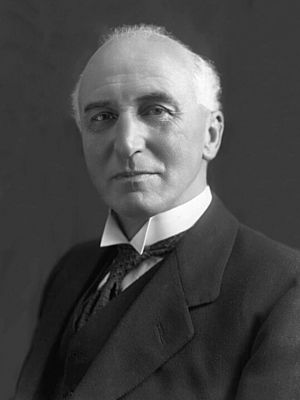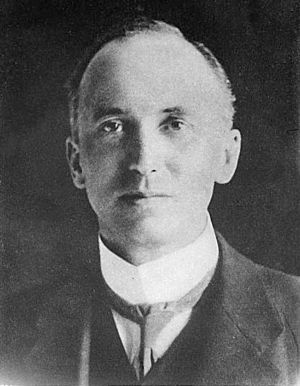John Simon, 1st Viscount Simon facts for kids
Quick facts for kids
The Viscount Simon
|
|
|---|---|

Simon in 1931
|
|
| Lord High Chancellor of Great Britain | |
| In office 10 May 1940 – 27 July 1945 |
|
| Prime Minister | Winston Churchill |
| Preceded by | The Viscount Caldecote |
| Succeeded by | The Viscount Jowitt |
| Chancellor of the Exchequer | |
| In office 28 May 1937 – 10 May 1940 |
|
| Prime Minister | Neville Chamberlain |
| Preceded by | Neville Chamberlain |
| Succeeded by | Sir Kingsley Wood |
| Foreign Secretary | |
| In office 5 November 1931 – 7 June 1935 |
|
| Prime Minister | Ramsay MacDonald |
| Preceded by | The Marquess of Reading |
| Succeeded by | Sir Samuel Hoare |
| Home Secretary | |
| In office 7 June 1935 – 28 May 1937 |
|
| Prime Minister | Stanley Baldwin |
| Preceded by | Sir John Gilmour |
| Succeeded by | Sir Samuel Hoare |
| In office 27 May 1915 – 12 January 1916 |
|
| Prime Minister | H. H. Asquith |
| Preceded by | Reginald McKenna |
| Succeeded by | Herbert Samuel |
| Attorney-General for England | |
| In office 19 October 1913 – 25 May 1915 |
|
| Prime Minister | H. H. Asquith |
| Preceded by | Sir Rufus Isaacs |
| Succeeded by | Sir Edward Carson |
| Solicitor-General for England | |
| In office 7 October 1910 – 19 October 1913 |
|
| Prime Minister | H. H. Asquith |
| Preceded by | Sir Rufus Isaacs |
| Succeeded by | Sir Stanley Buckmaster |
| Member of the House of Lords Lord Temporal |
|
| In office 20 May 1940 – 11 January 1954 Hereditary peerage |
|
| Preceded by | Peerage created |
| Succeeded by | The 2nd Viscount Simon |
| Member of Parliament for Spen Valley |
|
| In office 15 November 1922 – 1 June 1940 |
|
| Preceded by | Tom Myers |
| Succeeded by | William Woolley |
| Member of Parliament for Walthamstow |
|
| In office 8 February 1906 – 14 December 1918 |
|
| Preceded by | David John Morgan |
| Succeeded by | Seat abolished |
| Personal details | |
| Born |
John Allsebrook Simon
28 February 1873 Moss Side, Manchester, Lancashire, England |
| Died | 11 January 1954 (aged 80) Westminster, London, England |
| Political party | Liberal Party |
| Other political affiliations |
National Liberal Party |
| Spouses |
|
| Alma mater | Wadham College, Oxford |
John Allsebrook Simon, 1st Viscount Simon (born February 28, 1873 – died January 11, 1954) was an important British politician. He held many top jobs in the government from the start of the First World War until the end of the Second World War.
He is one of only three people to have been Home Secretary (in charge of internal affairs), Foreign Secretary (in charge of international relations), and Chancellor of the Exchequer (in charge of the country's money). He also served as Lord Chancellor, which is the most senior legal job in the British system. John Simon started his career with the Liberal Party. Later, he joined the National Government in 1931 and helped create the Liberal National Party. By the end of his career, he was mostly aligned with the Conservative Party.
Contents
Early Life and Education
John Simon was born in Moss Side, Manchester, England. His father was a minister in the Congregational Church. John went to King Edward's School, Bath, and then to Fettes College in Edinburgh. He was a top student and won many awards.
He then went to Wadham College, Oxford, in 1892. He studied hard and became the President of the Oxford Union, a famous debating society. After university, he became a lawyer, known for being very logical and good at explaining difficult cases. He worked extremely hard, often through the night.
Starting a Political Career
Simon became a Member of Parliament (MP) for Walthamstow in 1906, representing the Liberal Party. In 1908, he became a KC, which is a senior lawyer title.
In 1910, he became the Solicitor-General, a top legal advisor to the government. He was knighted, as was common for people in this role. At 37, he was one of the youngest Solicitor-Generals in many years. In 1912, he helped investigate the sinking of the RMS Titanic. His questions helped improve safety at sea.
In 1913, he was promoted to Attorney-General, another very important legal role. He was even made a full member of the Cabinet, which was unusual for an Attorney-General at the time. People thought he might become a future Liberal prime minister.
First World War and Beyond
When the First World War started in August 1914, Simon thought about resigning because he was against the war. However, he decided to stay in the government.
In May 1915, he became Home Secretary in the new government. This job involves looking after internal affairs and law and order. He resigned in January 1916 because he disagreed with the government's decision to introduce conscription, which meant forcing men to join the army. He felt this went against Liberal ideas.
After the war, Simon lost his seat in Parliament in the 1918 election. He tried to get back into Parliament in 1919 but lost again.
The 1920s: Back in Parliament
Simon returned to Parliament in 1922 as an MP for Spen Valley. From 1922 to 1924, he was the deputy leader of the Liberal Party.
In 1924, he helped bring down the first Labour government. After this, the Liberal Party became much smaller. Simon became less supportive of the Liberal leader, David Lloyd George, and grew closer to the Conservative leader, Stanley Baldwin. He then stepped down as deputy leader and went back to being a lawyer.
In 1926, during the General Strike, Simon stated that the strike was illegal. He was a highly respected legal expert. At this time, he was one of the highest-paid lawyers in the country.
From 1927 to 1931, he led the Simon Commission, a group that studied the future government of India. When the commission arrived in India in 1928, it was met with protests and slogans like "Simon Go Back." This was because there were no Indian members on the commission. Simon's report was very detailed, but its ideas were later overshadowed by promises of more self-rule for India.
The 1930s: National Government and Key Roles
In 1931, Simon and his supporters formed the Liberal Nationals. They started working closely with the Conservatives.
Foreign Secretary (1931-1935)
In November 1931, Simon became the Foreign Secretary. This meant he was in charge of Britain's relationships with other countries. During his time, several important world events happened:
- The Japanese invasion of Manchuria began. Simon was criticized for not strongly condemning Japan.
- Adolf Hitler came to power in Germany in 1933 and started rearming the country.
- The World Disarmament Conference failed to limit weapons globally.
Many people, including some of his colleagues, thought Simon was not a very good Foreign Secretary. They felt he was better at analyzing problems than at finding solutions and acting on them.
Home Secretary (1935-1937)
From 1935 to 1937, Simon served again as Home Secretary. This role was better suited to his skills. He helped pass the Public Order Act 1936, which limited the activities of political groups like Oswald Mosley's Blackshirts. He also played a key role during the Abdication Crisis in 1936, when King Edward VIII gave up his throne.
Chancellor of the Exchequer (1937-1940)
In 1937, Simon became Chancellor of the Exchequer, the person in charge of the country's money. He tried to keep spending on weapons low, believing that a strong economy was important for defense.
When the Second World War began in September 1939, Simon became a member of the small War Cabinet. He increased taxes significantly to help pay for the war. However, his political position weakened as people felt he was not fully committed to the war effort.
Lord Chancellor and Later Life
In May 1940, Winston Churchill became Prime Minister. Simon was not included in Churchill's main War Cabinet. Instead, he became Lord Chancellor, the highest legal officer in the country. This role was seen as a perfect fit for his legal talents. He made many important legal decisions during this time.
After the war ended in 1945, Simon left government and never held office again. He remained active in the House of Lords and as a senior judge. He also wrote a book about income tax.
John Simon died in 1954 at the age of 80. He was known for his sharp mind and hard work, but also for having a somewhat cold personality.
Private Life
Simon married Ethel Mary Venables in 1899. They had three children. Ethel died in 1902, soon after their son was born. Her death affected him deeply.
In 1917, he married Kathleen Manning, who had been a governess to his children. She was an activist against slavery.
Simon was a keen chess player. He was not always liked or trusted by other politicians, and he was never considered for the role of prime minister.
Images for kids
-
Dame Kathleen Simon, Viscountess Simon (17 February 1920)



